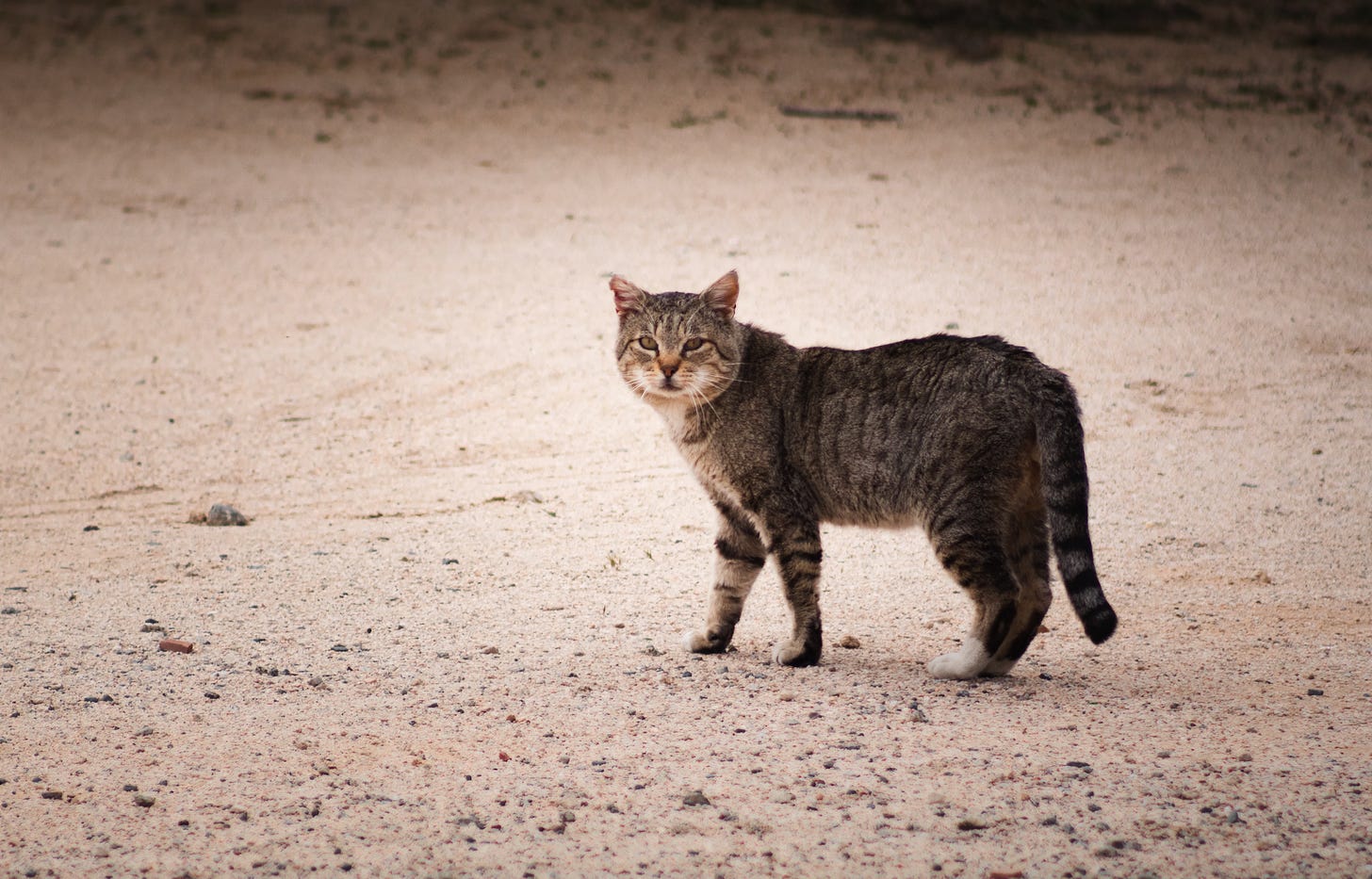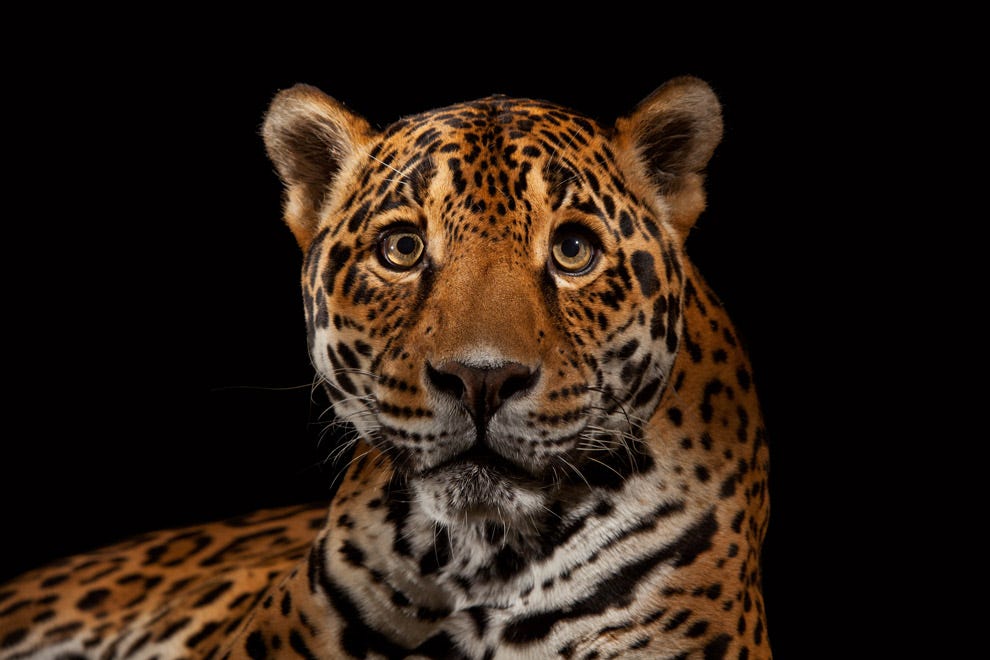Is Hope on the Horizon for the Free-Roaming Housecat Conundrum?
Feral and Stray Cats Present Hazards to Wildlife
By Jordan Schaul | National Geographic | October 4, 2013 (Edited)
While populations of wild cat species are disappearing almost everywhere they are found, housecats have more than narrowed in on that ubiquitous barking mammal, as the most popular companion animal in peoples’ homes. Unfortunately, it seems that free-roaming cat populations (e.g. strays and ferals) are booming to the dismay of wildlife conservationists, including those whose livelihoods are all about protecting the “big” cats.
Although feral dogs and other free-roaming domestic canids are also negatively impacting wildlife, dogs likely take much less of a toll on smaller ‘furry’ and ‘flighted’ fauna because they are not strict carnivores like cats or thought to be so hard-wired as far as predators go. Nor are they nearly as agile.
(As you can see in this photo on the right of a cat who seems to have befriended a barn owl, cats aren’t always the enemy of wildlife, or are they?)
The future of cats, big and small, remains uncertain on this planet as they attempt to co-exist with humans in increasingly smaller spaces. Whether they are sitting on our laps, navigating dense jungles and barren wild lands in pursuit of young hoofed mammals and smaller prey species or blocking safari traffic while sprawled out in the middle of the road, they are, dependent on size, either our companions or intriguing and majestic co-inhabitants of Earth.
Cats may have adapted to some extent to non-native landscapes with their awesome physiques—built for predation on just about anything that moves, but we can only expect so much of them.
With the exception of Antarctica, Australia, and few island archipelagos, domestic cats are native to just about every place. Where they are not indigenous, they have been introduced purposely such as on the island continent of Australia, where they have since wreaked havoc on native fauna, including small mammalian pests for which they were introduced to eradicate in the first place.
Unfortunately, and to no fault of their own, cats have jeopardized the future of an array of non-feline wildlife species due to the reckless forethought of colonial peoples, rendering some of these prey species extinct, if not conservation-sensitive.
From the wide-ranging Afro-Asian leopards (Panthera pardus spp.) to the “barely ranging” Spanish lynx, cat species are fairly successful as a taxonomic group. Cats are carnivorans (i.e. mammalian carnivores) and they are usually keystone predators and considered flagship species wherever they occur. There are 37 species of wild cats and a great majority of them are found on one continent—Asia.
Hopefully, we can find new measures to control problems associated with free-roaming domestic cat populations before it is too late for the pantherine lineage—the cats we call the “big cats,” and other wild cat species.
As I stated recently, I am a proponent of a “no-kill” nation, if not a “no-kill” world and I hope we seek humane methods to save big and small cats wherever they call home.
Fortunately, there is some good news concerning free-roaming cat control:
“As I mentioned in an earlier post, “a recent study suggests that vasectomized or hysterectomized (TVHR) cat populations are even ‘less sustainable’ or easier to extinguish than TNR populations. In fact, in a blog post summarizing the study, Nat Geo News staff writer Christine Dell’Amore reported the following:
‘The results showed that if 35 percent of a cat population underwent TVHR, that population would be reduced by half and would disappear in 11 years. Alternatively, if the cat population underwent TNR, 82 percent of cats would need to be captured and neutered in order to eliminate the colony in 11 years.'”
This is promising news for cats of all sizes.
(Photos belong to the National Geographic Society)
(My Related Post for NAT GEO CAT WATCH)
ABOUT NATIONAL GEOGRAPHIC SOCIETY
The National Geographic Society is a global nonprofit organization that uses the power of science, exploration, education and storytelling to illuminate and protect the wonder of our world. Since 1888, National Geographic has pushed the boundaries of exploration, investing in bold people and transformative ideas, providing more than 14,000 grants for work across all seven continents, reaching 3 million students each year through education offerings, and engaging audiences around the globe through signature experiences, stories and content. To learn more, visit www.nationalgeographic.org or follow us on Instagram, Twitter and Facebook.
MEET THE AUTHOR
Jordan Carlton SchaulWith training in wildlife ecology, conservation medicine, and comparative psychology, Dr. Schaul's contributions to Nat Geo Voices have covered a range of environmental and social topics. He draws particular attention to the plight of imperiled species highlighting issues at the juncture or nexus of sorta situ wildlife conservation and applied animal welfare. Sorta situ conservation practices are comprised of scientific management and stewardship of animal populations ex situ (in captivity / 'in human care') and in situ (free-ranging / 'in nature'). He also has a background in behavior management and training of companion animals and captive wildlife, as well as conservation marketing and digital publicity. Jordan has shared interviews with colleagues and public figures, as well as editorial news content. In addition, he has posted narratives describing his own work, which include the following examples: • Restoration of wood bison to the Interior of Alaska (As Animal Curator at Alaska Wildlife Conservation Center and courtesy professor at the University of Alaska) • Rehabilitation of orphaned sloth bears exploited for tourists in South Asia (As executive consultant 'in-residence' at the Agra Bear Rescue Center managed by Wildlife SOS) • Censusing small wild cat (e.g. ocelot and margay) populations in the montane cloud forests of Costa Rica for popular publications with 'The Cat Whisperer' Mieshelle Nagelschneider • Evaluating the impact of ecotourism on marine mammal population stability and welfare off the coast of Mexico's Sea of Cortez (With Boston University's marine science program) Jordan was a director on boards of non-profit wildlife conservation organizations serving nations in Africa, North and South America and Southeast Asia. He is also a consultant to a human-wildlife conflict mitigation organization in the Pacific Northwest. Following animal curatorships in Alaska and California, he served as a charter board member of a zoo advocacy and outreach organization and later as its executive director. Jordan was a member of the Communication and Education Commission of the International Union for the Conservation of Nature (CEC-IUCN) and the Bear Specialist Group of the IUCN Species Survival Commission (BSG-SSC-IUCN). He has served on the advisory council of the National Wildlife Humane Society and in service to the Bear Taxon Advisory Group of the Association of Zoos and Aquariums (AZA Bear TAG). In addition, he was an ex officio member of the council of the International Association for Bear Research and Management.




